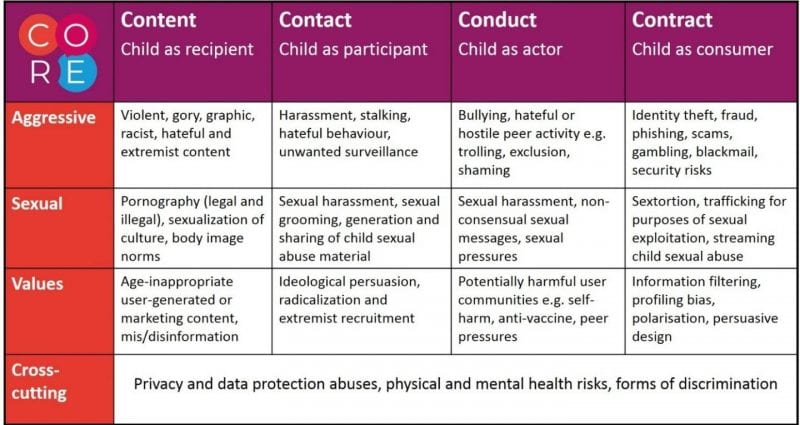Initially, there were only three official C’s of internet risk safety, those being contact, content, and conduct risks. They were originally developed in 2009 as a framework to answer the burning questions of parents and caretakers, such as “What are the online risks our kids are facing?”. When the initial three C’s were created, the idea was to categorize specific risks based on their causes and consequences, thus broadening the public view beyond the dominant risks at the time, namely grooming, pornography, and cyberbullying.
As the internet grows and evolves, so do the number of risks our kids are exposed to. We therefore need updated risk classification guides and solutions to deal with them. As of 2021, the report released by Children Online: Research and Evidence (CO:RE) states that the new Four C’s of internet risk are content, contact, conduct, and contract.
It states that risk arises when a child:
- is exposed to and/or engages with potentially harmful content
- experiences and/or is targeted by potentially harmful contact
- participates in, witnesses, and/or is a victim of potentially harmful conduct
- is party to and/or exploited by a potentially harmful contract

The 4Cs can also distinguish between aggressive, sexual and value risks. In addition to the updated 4Cs, the new CO:RE classification acknowledges converging risks, notably to children’s privacy, health, and their fair treatment. Although some risks naturally intersect, many of the online risks faced by children overlap. This is dependent on circumstances and is even more important as the digital environment evolves.
Children are naturally curious creatures, therefore, they are keen to explore the digital world, however, they may not be mature enough to understand and manage the risks they face. You can help your children manage these risks by simply starting a conversation at home. Just a few simple questions can help you better understand your child and the risks they face daily:
Where do you go, and what do you see?
- This gives you insight into the type of content they come across and actively seek out. This allows you to introduce your children to content risks.
What do you do online?
- This question can help you identify, understand, and manage conduct risks, such as chatting anonymously in chat rooms, or publishing their personal information publicly.
Who do you chat to online?
- This question addresses contact risks, particularly if your child says they do not know they people they chat to in real life.
Which web services/apps do you use?
- This helps introduce the risk of contract to them. You can go on to explain that nothing is ever truly free online, and that web services and social media platforms usually hand out your information to third parties.
Once you understand the risks your child may face online, it becomes easier to tailor conversations to their specific risk factors. Just like the offline world, the world of the internet is full of digital risks. Although a majority of these may never turn into physical, real-world harm, it is essential that children understand the risks they are taking, and make sensible, responsible choices online.
